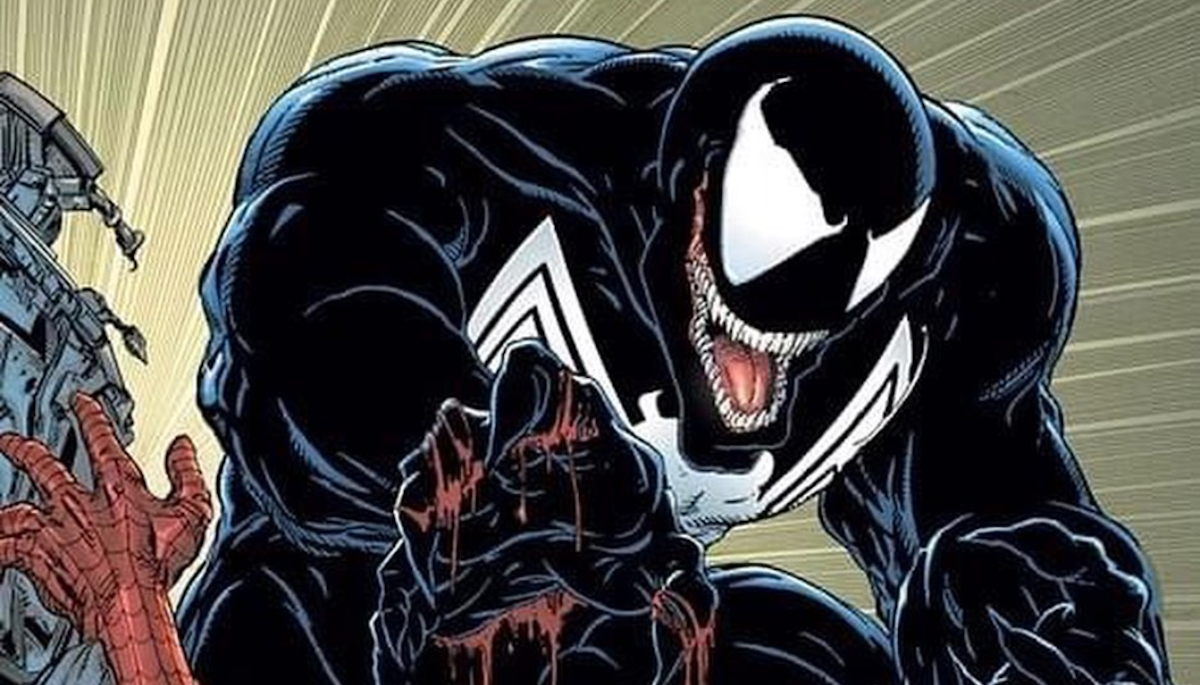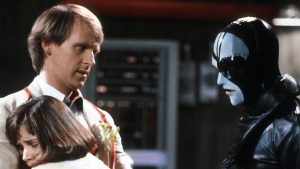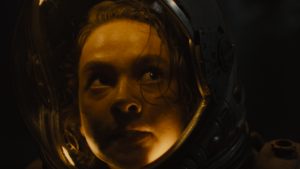
2018’s Venom will go down as a bizarre footnote in the history of superhero movies. Coming out when the Marvel Cinematic Universe was at its strongest, and the DC Comics Extended Universe hit a major snag with Justice League, Venom became a surprise success. Equal parts stupid and fun, it inspired Sony to not only make sequels, but also mine other Spider-Man-related characters to create their own cinematic universe. While Disney almost has a monopoly on Marvel properties now, there remains off to the side this bizarre pocket of movies about Morbius and Madame Web. They’re not part of the MCU itself, yet are still connected to its multiverse. And they’re sure to confuse future generations of geeks.
The thing is, we could have had a similar situation play out decades ago. Back in the ‘90s, New Line Cinema was able to buy the rights to Venom as its own franchise, separate from Sony’s planned Spider-Man. The screenplay was put together by David S. Goyer, the man who would become the one recurrent thread in the Blade Trilogy, besides Wesley Snipes, as well as one of the writers on the Dark Knight Trilogy. He’s also responsible for that one scene where Jonathan Kent considers the idea of letting innocent children die in Man of Steel. Had it gotten picked up, we would be living in a reality where Venom got his own box office spotlight before the very hero he’s based off.
Now that the dust is settled on the Venom movies, how does this potential original compare?
The Source Material
After being Spider-Man’s hot new villain for a little while, Marvel decided to give Venom his own comic for five years in the ‘90s. The premise was that Eddie Brock was a self-righteous vigilante who was also a complete mess of a man with no real idea about what he was doing. Instead of a simple ongoing series, Marvel just released each story arc as its own limited series because it meant more eye-catching #1 issues, making it a pain to figure out the reading order. Once this series ran its course, Marvel spent years trying to have its cake and eat it too. Between putting the Venom symbiote onto different hosts and different symbiotes onto Eddie, they kept trying to both have an antihero Venom and a villain Venom at the same time.
Both Goyer’s original screenplay and the eventual Venom movies starring Tom Hardy are based on this five-year antihero run. The first Hardy movie was loosely based on Venom: Lethal Protector and the third movie, despite the inclusion of modern villain Knull, was mostly an adaptation of Venom: The Hunted.
Conversely, Goyer’s 1997 screenplay was based on Venom: Carnage Unleashed and the Spider-Man crossover Planet of the Symbiotes, though with elements of Venom: The Madness, Venom: Sinner Takes All, and Maximum Carnage thrown in for good measure.
Eddie Brock/Eddy Brock
Yes, in the screenplay, our antihero is named “Eddy.” Just go with it. The claim I’ve seen with this hypothetical movie is that they would have gotten Dolph Lundgren to play the part, and while ‘90s comic book Eddie Brock absolutely looks like Ivan Drago with five o’clock shadow, I don’t believe it. Ignoring that Lundgren was doing straight-to-video movies by this point (so ripe for internet fandom casting), the protagonist in this screenplay surely does not sound like someone who should be played by Lundgren. He’s a sad sack who gets pushed around by everyone, and even jokes about his lack of physique at one point. You get the idea that pre-bite Peter Parker would have shoved this guy into a locker.
He’s just as much a failed journalist and hasbeen loser as Hardy’s version of the character, but Hardy’s Eddie suffered because he pushed too hard and was fearless when he should have known better. The screenplay’s Eddy has a very ill-explained reason for him letting everyone walk over him, which ties into his history with Cletus Kasady. It’s easy to speculate that Goyer was blatantly just inspired by 1994’s The Mask, as the first half feels way more like him trying to rewrite it as a sci-fi flick instead of a story of Norse magic. Also, it’s worth noting, this screenplay is dated three years after New Line Cinema had massive success with Jim Carrey in a green mask going from loser to cartoon-abuser.
The Venom Symbiote
The Venom movies of the last six years are really held together by Hardy’s double role and how he plays off himself. The Venom symbiote is there for dialogue, exposition, and comedy. Unfortunately for Goyer’s screenplay, the symbiote having its own voice was more of a recent invention in the comics. Usually, Goyer’s Eddie would just talk out loud and have a one-sided conversation that we weren’t privy to. Therefore the only insight we get from the symbiote in the script is a moment where it takes over Eddie completely to give some exposition.
Using a development from the Planet of the Symbiotes storyline, the Venom symbiote is an outlier and enemy to its race due to its interest in having a full partnership with its host instead of just puppeting them, sucking them dry, and moving on to the next meal. It’s a lot more detailed than the 2018 movie’s brief mention of, “on my planet I am a loser.” It feels more important too.
Spider-Man Without Spider-Man
Currently, Sony has a complicated business agreement with Disney that limits its use of Spider-Man in their Spider-adjacent movies. They have at least been able to do things like include John Jameson, reference the 1990s Spider-Man cartoon with the way the Venom symbiote came to Earth in the first place, and even get that Venom: Let There Be Carnage MCU cliffhanger that went nowhere, with Eddie Brock entering the MCU timeline for half a minute. They can gesture toward Spider-Man, but it’s been three movies and Venom’s yet to have that cool white spider symbol on his chest.
The Goyer script is also limited, as this was going to be a different studio completely. Spider-Man was completely off the table. However, Goyer did a decent enough stretch by making the symbiote race’s last planet be made of spider-like creatures. The Venom symbiote would have the logo on its chest as a sign of respect and pure symbiosis. It would also incorporate spider legs into its power set, which gets us to…
Venom’s Powers
Ignoring how all of that mass displacement works, the 2020s movies are somewhat grounded in how Venom does his thing. It’s a blob of liquid that can turn its host into a toothy Hulk with some goo tentacles occasionally thrown in. Crazy-looking, but overall simple, and understanding that there is a human body underneath it all.
Goyer’s Venom, by comparison, has a little too much in his arsenal. Some of it was stuff from the comics, like camouflage, shape-shifting, and even traveling through phone lines when unattached to a host. Other times it would be a little too cartoonish, with no regard for Eddy’s body underneath the alien. For example, he could stretch his arms out like Mr. Fantastic, travel through pipes while attached to Eddie, and could turn completely flat on the hood of a car before fixing himself. Again, this movie was absolutely trying to be The Mask, just with more scenes of our hero inexplicably growing eight spider legs to move around.
Carnage
Cletus Kasady is the screenplay’s one bright spot. With the right actor, this could have been a fun performance. As children, Kasady burned down the orphanage where he and Eddy lived. Since then he became a prolific serial killer, giving himself the nickname “Carnage” and sending Eddy stories about his victims. He got caught eventually, but his charisma and philosophies have garnered him a huge cult following, with people willing to riot in his name. He’s become such a media sensation, that the plan is to execute him live on TV. (Ironically, this plays vaguely at times like Natural Born Killers, a movie which starred future Carnage actor Woody Harrelson.)
The Carnage symbiote, introduced as the Blood Hunter, is a higher-ranking part of the symbiote species in Goyer’s script and it is tasked with hunting down the black Venom symbiote. It ends up seeking out Kasady, purely because it knows who the Venom symbiote attached itself to, and is intelligent enough to seek a host who has some kind of physical and psychological power over Eddy.
Carnage is not the only antagonist in the story, as there are military guys out to capture the symbiotes and weaponize them for the U.S. government. That stuff isn’t all that interesting, but it does lead to the next bit.
She-Venom
Yes, of all the things for the 2018 version to have in common with the 1997 script, it’s the inclusion of She-Venom, including the bit where she transfers the symbiote back onto Eddy via making out with him. Initially, the comic Venom: Sinner Takes All had a segment where Eddie’s ex-wife Anne Weying was horribly injured and the only way to save her life was to force her to bond with the symbiote. She briefly ended up becoming She-Venom, murdered some guys to save Eddie, then acted horrified at her actions. It at least made for an enticing issue cover.
The Venom movies did have Anne (played by Michelle Williams) act as host to the symbiote a couple times. In the 1997 screenplay, the love interest is a weird amalgamation of different characters named Rachel Kafka. Rachel is Kasady’s psychiatrist, based on the minor recurring Marvel character Ashley Kafka from the comics. While Kafka has never been romantically linked with Eddie in the comics (though she does in that ‘90s Spider-Man cartoon!), she is merged here with Anne as well Eddie’s lesser-known flame Beck Underwood. Still, the origin of her becoming She-Venom is at least more loyal to the source material.
Eddy and Rachel don’t have nearly enough screen time for their relationship to be believable, but the mind-melding that comes from having them share Venom at least allows an explanation for how she understands what’s truly in his heart and all that mushy stuff.
The Ending
The final battle between Venom and Carnage isn’t bad. Rachel gets just enough to do, Carnage gets a gnarly final form, and the best is how they play into the Carnage symbiote’s vampiric nature. While it loves what Kasady stands for, it’s still gradually eating away at him, including his psyche, making him more frantic and insane as the climax goes on.
Weirdly enough, Carnage’s death is exactly like Venom’s death in Sam Raimi’s Spider-Man 3. Replace the pumpkin bomb with a white phosphorus grenade, and it’s the same visual, down to Cletus running into the explosion while begging for his symbiote not to leave him. We also get a finale like Hardy’s first Venom where the symbiote appears to be dead, but Eddie secretly knows it’s alive within him and refuses to tell his lady friend.
Unfortunately, the whole plot line about Carnage causing a NYC-destroying riot just quietly ends. There’s no interesting conclusion to that. Just “the national guard showed up and put a stop to it.” Yeah. Feels a bit anticlimactic.
Would It Have Worked?
Goyer’s screenplay has plenty of problems. There are supporting characters who seem important, only to disappear early on and never be heard from again. Eddy’s character arc is empty at worst and confusing at best. Building up a huge riot as a backdrop, then shrugging it off so the movie could end is certainly a choice. It needed at least a few rewrites to turn it into something coherent.
There are parts that could have worked in David S. Goyer’s Venom, but only on paper. Sony’s three Venom movies each have in-story reasons to keep Eddie from constantly going into full Venom mode and costing them all that CGI money. The amount of CGI—especially late-‘90s CGI—that this script would have asked for would not have been viable, especially after New Line’s Spawn bombed earlier that year. Sadly, the world was not ready for Venom and Carnage brawling on the big screen just yet.
Still, imagine a world where that happened before Tobey Maguire fought Willem Dafoe. Huh.
The post Inside the ’90s Venom Movie David Goyer Almost Made appeared first on Den of Geek.






